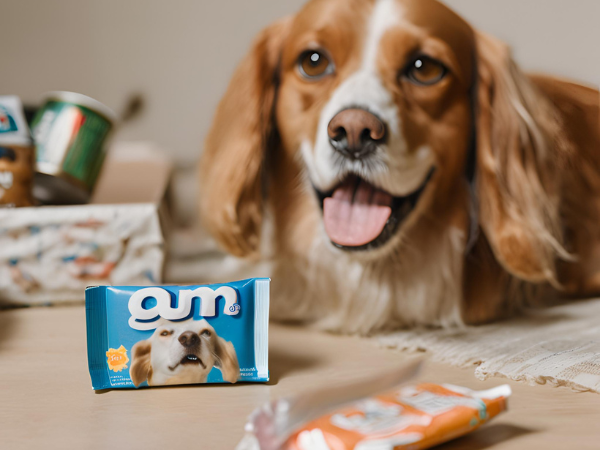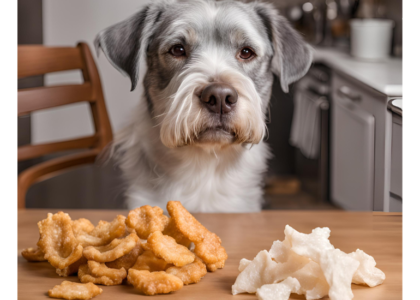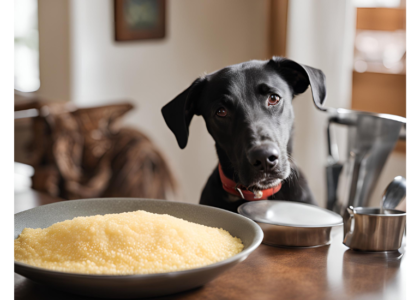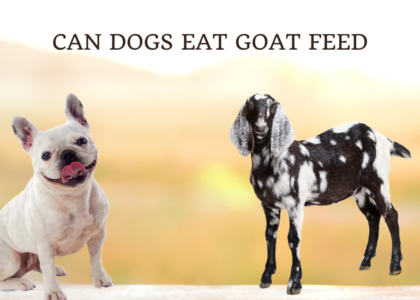No, dogs should not eat gum. Gum often contains xylitol, which is toxic to dogs.
Dogs are curious creatures and often get into things they shouldn’t. Gum, a common household item, poses a significant risk to dogs due to the presence of xylitol. This artificial sweetener, found in many sugar-free gums, can cause severe health issues in dogs, including hypoglycemia and liver failure.
Even a small amount of xylitol can be dangerous. Symptoms of xylitol poisoning include vomiting, loss of coordination, and seizures. Immediate veterinary attention is crucial if a dog consumes gum. Always keep gum and other xylitol-containing products out of your pet’s reach to ensure their safety and well-being.
Table of Contents
Symptoms Of Gum Ingestion In Dogs
Dogs are curious animals. They often eat things they shouldn’t. Gum is one such item that can be dangerous. It’s important to know the symptoms of gum ingestion in dogs. This helps to ensure their safety and well-being.
Digestive Issues
When a dog eats gum, it can cause digestive issues. The gum can block their intestines. This leads to a condition called an intestinal obstruction. Here are some signs to watch for:
- Vomiting
- Loss of appetite
- Straining to poop
- Abdominal pain
Dogs may also experience bloating. This happens when gas builds up in their stomach. Bloating can be very painful for dogs. It can even be life-threatening. Prompt treatment is crucial.
Another issue is constipation. Gum doesn’t break down easily. It can harden in the intestines. This makes it hard for the dog to poop. They may strain or have dry, hard stools.
In some cases, the gum may pass through the digestive system. But, it can cause irritation. This leads to diarrhea. It’s essential to monitor your dog’s poop. Changes can indicate a problem.
Toxicity Symptoms
Many gums contain xylitol. This is a sugar substitute. Xylitol is highly toxic to dogs. Even a small amount can cause serious health issues. Symptoms of xylitol poisoning include:
- Weakness
- Seizures
- Loss of coordination
- Tremors
Xylitol causes a rapid release of insulin. This leads to hypoglycemia (low blood sugar). Signs of hypoglycemia include:
- Lethargy
- Confusion
- Collapse
Without treatment, hypoglycemia can be fatal. It’s crucial to act quickly. Call your vet if you suspect xylitol poisoning.
Another concern is liver damage. Xylitol can affect liver function. Signs of liver damage include:
- Jaundice (yellowing of the skin and eyes)
- Vomiting
- Increased thirst and urination
Keep all gum out of reach of your dog. This prevents accidental ingestion. Knowing the symptoms can save your dog’s life.
Treatment For Gum Ingestion
Dogs are curious creatures and often eat things they shouldn’t. One common concern among pet owners is gum ingestion. If your dog eats gum, it can be dangerous, especially if the gum contains xylitol, a toxic substance for dogs. Knowing the proper treatment for gum ingestion is crucial to ensure your furry friend’s safety and health.
Inducing Vomiting
If your dog has ingested gum, inducing vomiting might be necessary. This should be done within 30 minutes to an hour of ingestion. Here are the steps:
- Contact your veterinarian immediately for advice.
- Administer hydrogen peroxide as directed by your vet. Typically, the dosage is 1 teaspoon per 10 pounds of body weight.
- Use a syringe to administer the hydrogen peroxide orally.
- Wait for about 10 to 15 minutes for the vomiting to occur.
- If your dog does not vomit, do not administer more hydrogen peroxide without consulting
Prevention Methods
Dogs are curious creatures and often explore their surroundings with their mouths. This can lead to dangerous situations, especially if they ingest something harmful like gum. Gum can be toxic to dogs, especially if it contains xylitol, a common sugar substitute. Prevention is key to keeping your furry friend safe. Let’s explore some effective prevention methods to ensure your dog stays healthy and happy.
Keeping Gum Out Of Reach
One of the simplest and most effective prevention methods is to keep gum out of your dog’s reach. Dogs can be very resourceful, so it’s important to be diligent. Here are some tips:
- Store gum in high cabinets: Ensure all gum and candy products are stored in cabinets that are too high for your dog to reach.
- Use pet-proof containers: Invest in containers that are designed to be difficult for pets to open.
- Educate family members: Make sure everyone in the household knows the dangers of leaving gum where the dog can get it.
- Check bags and purses: Always check bags and purses for gum before leaving them where your dog can access them.
For better organization, you can use a table to keep track of safe storage practices:
| Storage Method | Effectiveness |
|---|---|
| High Cabinets | Very Effective |
| Pet-proof Containers | Effective |
| Family Education | Moderately Effective |
| Checking Bags | Effective |
By implementing these methods, you can significantly reduce the risk of your dog ingesting gum.
Alternative Chewing Options
Providing your dog with safe and enjoyable chewing options is another great way to prevent them from seeking out gum. Here are some alternatives:
- Dog Chew Toys: Invest in high-quality, durable chew toys designed specifically for dogs.
- Natural Chews: Consider natural options like bully sticks or antlers, which are safe and satisfying for dogs.
- Interactive Toys: Toys that dispense treats can keep your dog engaged and less likely to seek out forbidden items.
- Frozen Treats: Freeze peanut butter or yogurt in a Kong toy for a long-lasting and safe treat.
Here’s a quick comparison of some popular chewing options:
| Chewing Option | Safety | Engagement Level |
|---|---|---|
| Dog Chew Toys | Very Safe | High |
| Natural Chews | Safe | Moderate |
| Interactive Toys | Very Safe | Very High |
| Frozen Treats | Safe | High |
By offering these alternatives, you can keep your dog entertained and safe from harmful items like gum.

Dog-friendly Chewing Alternatives
Many pet owners wonder about the safety of everyday items, like gum, for their furry friends. Can dogs eat gum? The answer is a resounding no. Gum can be harmful and even toxic for dogs. Luckily, there are many dog-friendly chewing alternatives that can keep your pet happy and healthy. This blog post explores safe chews for dogs and DIY chewing toys that can serve as fun and safe options.
Safe Chews For Dogs
When it comes to safe chews for dogs, you have plenty of options that are both nutritious and enjoyable. These alternatives can keep your dog entertained and help maintain their dental health.
- Rawhide Bones: These chews are popular and can last a long time. Always choose high-quality rawhide to avoid digestive issues.
- Dental Chews: Specially designed to clean teeth and freshen breath, dental chews are a great option. Look for vet-approved brands.
- Rubber Chew Toys: Durable and safe, rubber toys like KONGs can be filled with treats to keep your dog busy.
- Bully Sticks: Made from natural beef, bully sticks are a tasty and long-lasting option.
- Carrots: A healthy and natural choice, carrots are low in calories and good for your dog’s teeth.
Here is a quick comparison of some popular safe chews:
| Chew Type | Durability | Health Benefits |
|---|---|---|
| Rawhide Bones | High | Good for dental health |
| Dental Chews | Medium | Freshens breath, cleans teeth |
| Rubber Chew Toys | Very High | Entertaining, safe |
| Bully Sticks | Medium | High in protein |
| Carrots | Low | Low calorie, good for teeth |
Diy Chewing Toys
Creating DIY chewing toys for your dog can be a fun and cost-effective way to keep them entertained. Here are some easy-to-make options:
- Frozen Treats: Fill an ice cube tray with water, broth, or yogurt. Add small pieces of fruit or dog-safe vegetables. Freeze and serve as a refreshing chew toy.
- T-Shirt Rope Toy: Cut an old t-shirt into strips. Braid the strips together and tie the ends in knots. This makes a durable and washable chew toy.
- Sock Ball: Put a tennis ball inside a long sock. Tie a knot at the open end. This simple toy is great for fetch and chewing.
- Plastic Bottle Cruncher: Place an empty plastic bottle inside a sock. Tie the end of the sock. The crinkly sound will keep your dog entertained.
- DIY Puzzle Toy: Use a muffin tin and place treats in each cup. Cover the treats with tennis balls. Your dog will have to remove the balls to get the treats.
These DIY toys are easy to make and can provide hours of entertainment for your dog. Plus, they are safe and made from materials you likely already have at home.
Final Thoughts
Can dogs eat gum? This question often puzzles pet owners. Understanding the dangers of gum for dogs is crucial. In the final thoughts section, we’ll discuss raising awareness and promoting dog safety regarding gum consumption.
Raising Awareness
Many people do not know that gum can be deadly for dogs. Chewing gum often contains xylitol, a sugar substitute harmful to dogs. Raising awareness about this danger can save many pets.
Xylitol causes a rapid release of insulin in dogs. This can lead to a dangerous drop in blood sugar levels. Some symptoms of xylitol poisoning include:
- Vomiting
- Loss of coordination
- Seizures
- Coma
Awareness can be spread through social media, community events, and vet clinics. Pet owners should check ingredient lists for xylitol in all products, not just gum. This includes toothpaste, mouthwash, and certain foods.
A simple table of products containing xylitol can help:
| Product | Contains Xylitol |
|---|---|
| Chewing Gum | Yes |
| Toothpaste | Yes |
| Peanut Butter | Sometimes |
| Baked Goods | Sometimes |
Educating children about the dangers of gum for pets is also important. Kids can sometimes leave gum where dogs can reach it. By teaching them, we can prevent many accidents.
Promoting Dog Safety
Promoting dog safety involves proactive steps. Store gum and other xylitol products out of reach of pets. Use high shelves or closed cabinets.
Train your dog to avoid eating things from the ground. Commands like “leave it” and “drop it” can be lifesaving. Positive reinforcement training can help.
Keep an emergency vet contact handy. If your dog ingests gum, immediate action is crucial. Symptoms can appear quickly, so speed is essential.
Here are steps to follow if your dog eats gum:
- Remove any remaining gum from your dog’s mouth.
- Call your vet or a pet poison helpline immediately.
- Monitor your dog for symptoms like vomiting or loss of coordination.
- Follow the vet’s instructions carefully.
Regular vet visits help ensure your dog stays healthy. Discuss potential hazards like xylitol with your vet. Being informed can prevent many problems.
Use dog-safe products whenever possible. Choose toothpaste and treats made specifically for pets. This reduces the risk of accidental poisoning.
Frequently Asked Questions
Can Dogs Safely Eat Gum?
No, dogs should not eat gum. Many gums contain xylitol, which is toxic to dogs. Xylitol can cause a rapid insulin release, leading to hypoglycemia. Always keep gum out of reach of your pets.
What Happens If A Dog Eats Gum?
If a dog eats gum, it can suffer from xylitol poisoning. Symptoms include vomiting, loss of coordination, and seizures. Immediate veterinary care is essential. If untreated, it can be fatal.
How Much Gum Is Toxic To Dogs?
Even a small amount of xylitol-containing gum can be toxic to dogs. Just 0. 1 grams of xylitol per kilogram of body weight can cause hypoglycemia. Always check ingredient labels and keep gum away from dogs.
Can Sugar-free Gum Harm Dogs?
Yes, sugar-free gum often contains xylitol, which is harmful to dogs. Xylitol can cause a severe drop in blood sugar. It can also lead to liver failure. Seek veterinary care immediately if ingested.
Conclusion
Gum can be dangerous for dogs due to xylitol. Always keep gum out of your pet’s reach. If your dog ingests gum, consult a vet immediately. Prioritize your dog’s health by avoiding harmful foods. Stay informed to ensure your furry friend stays safe and happy.










